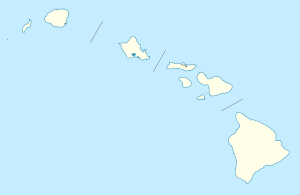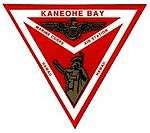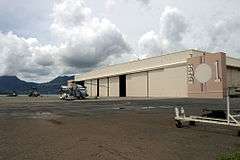Marine Corps Air Station Kaneohe Bay
| MCAS Kaneohe Bay | |||||||||||
|---|---|---|---|---|---|---|---|---|---|---|---|
 Aerial photograph of MCAF Kaneohe Bay. | |||||||||||
|
IATA: NGF – ICAO: PHNG – FAA LID: NGF – WMO: 91176 | |||||||||||
| Summary | |||||||||||
| Airport type | Military | ||||||||||
| Operator | United States Marine Corps | ||||||||||
| Serves | Marine Corps Base Hawaii | ||||||||||
| Location | Kaneohe, Hawaii | ||||||||||
| Built | 1939 | ||||||||||
| In use | 1939-1949, 1952 - present | ||||||||||
| Commander | LtCol D. Mark Angersbach[1] | ||||||||||
| Elevation AMSL | 24 ft / 7 m | ||||||||||
| Website | www.mcbhawaii.marines.mil/... | ||||||||||
| Runways | |||||||||||
| |||||||||||
|
Kanehoe Naval Air Station | |
|
During the Attack on Pearl Harbor, portions of Hangar 1 were destroyed. In 1987, the hangar and five sea plane ramps were designated a National Historic Landmark. | |
 | |
| Nearest city | Kailua, Honolulu County, Hawaii |
|---|---|
| Coordinates | 21°26′45″N 157°46′11″W / 21.44583°N 157.76972°WCoordinates: 21°26′45″N 157°46′11″W / 21.44583°N 157.76972°W |
| Area | 41-acre (17 ha) |
| Built | 1941 |
| Architect | United States Navy |
| NRHP Reference # | 87001299[4] |
| Significant dates | |
| Added to NRHP | May 28, 1987 |
| Designated NHLD | May 28, 1987[5] |
Marine Corps Air Station Kaneohe Bay or MCAS Kaneohe Bay (IATA: NGF, ICAO: PHNG, FAA LID: NGF) is a United States Marine Corps airfield located within the Marine Corps Base Hawaii complex, formerly known as Marine Corps Air Facility (MCAF) Kaneohe Bay or Naval Air Station (NAS) Kaneohe Bay.[2] It is located two miles (3 km) northeast of the central business district of Kaneohe, in Honolulu County, Hawaii, United States. The airfield has one runway (4/22) with a 7,771 x 200 ft (2,369 x 61 m) asphalt surface.[3]
History
Fort Hase and NAS Kaneohe Bay
The United States Army acquired 322 acres (1.30 km2) of the peninsula when President Woodrow Wilson signed executive order 2900 establishing the Kuwaaohe Military Reservation. Little is known about the operations of the fort, however, at the end of World War I, the military property was leased for ranching. In 1939, Kuwaaohe was reactivated, subjected to many name changes to include Camp Ulupa’u, and eventually named Fort Hase.
Prior to and during World War II, Fort Hase grew from a humble beginning as a defense battalion to a major unit of the Windward Coastal Artillery Command. Navy planners began to eye the peninsula in 1939 as the home of a strategic seaplane base. They liked the isolated location, the flat plains for an airfield and the probability of flights into prevailing trade winds. In 1939, the Navy acquired 464 acres (1.88 km2) of the peninsula for use of the PBY Catalina Patrol seaplanes for long-range reconnaissance flights. One year later, the Navy owned all of the Mokapu Peninsula except for Fort Hase.
On December 7, 1941, the Imperial Japanese Navy attacked the air station minutes prior to the attack on Pearl Harbor. Of the 36 Catalinas stationed here, 27 were destroyed and six others were damaged, along with 18 sailors who perished in the attack. The first Japanese aircraft destroyed in action were shot down at Kaneohe, along with Aviation Ordnanceman Chief Petty Officer John William Finn becoming one of the first Medal of Honor recipients of World War II for valor on that day.
During the war, the air station was a major training base in the Pacific Theater. The Fleet Gunnery School trained thousands of Navy gunners. There was a school for celestial navigation, sonar, aircraft recognition, and turret operations. Flight instructors also trained Navy and Marine Corps aviators in flight operations prior to being sent to a forward combat area. Following the war, Fort Hase had become a skeleton outpost and the air station consisted of limited air operations, a small security detachment, and a federal communications center.
Marine Operations
In 1949, the Navy decommissioned the air station. On January 15, 1952 the Marine Corps re-commissioned the idle airfield Marine Corps Air Station Kaneohe Bay, making it an ideal training site for a combined air/ground team. Station Operations and Headquarters Squadron supported flight operations until June 30, 1972, when Station Operations and Maintenance Squadron was commissioned in its place. SOMS served until it was disbanded on July 30, 1994. Marine Corps Air Facility Kaneohe Bay was formed on that date and continues today to serve the operational needs of the aviation community.
On May 28, 1987, the National Register of Historic Places listed "Kaneohe Naval Air Station" as a historic district and a National Historic Landmark.[5][6][7]
Following the 1993 Base Realignment and Closure Commission decision to close Naval Air Station Barbers Point, the base acquired 4 Navy P-3 Orion patrol squadrons and one SH-60 Seahawk Anti-Submarine squadron in 1999. Today there are almost 10,000 active duty Navy and Marine Corps personnel there, directed by Marine Aircraft Group 24 and Navy Patrol and Reconnaissance Wing 2.
The installation was re-designated as an Air Station (vice an Air Facility) in May 2009.[8] At the same time, the airfield was named for MajGen Marion Eugene Carl, and the Corps announced that new squadrons would be stationed there.
On January 15, 2016, two Marine helicopters from the air station collided over the North Shore of Oahu, leaving 12 US Marines missing and feared dead.[9]

Old MCAS Kaneohe Bay insignia 
Old MCAS Kaneohe Bay patch
See also
| Wikimedia Commons has media related to Marine Corps Air Station Kaneohe Bay. |
References
- ↑ Commanding Officer on MCAS Kaneohe Bay website
- 1 2 MCAS Kaneohe Bay, official website, retrieved 2011-4-11
- 1 2 FAA Airport Master Record for NGF (Form 5010 PDF), effective 2007-10-25
- ↑ National Park Service (2008-04-15). "National Register Information System". National Register of Historic Places. National Park Service.
- 1 2 "Kaneohe Naval Air Station". National Historic Landmark summary listing. National Park Service. Retrieved 2008-07-04.
- ↑ "NPS Form 10-900: National Register of Historic Places Inventory Nomination Form" (PDF). National Register of Historic Places. National Park Service. June 17, 1986. Retrieved 21 March 2011.
- ↑ "NPS Form 10-900; attached photos" (PDF). National Register of Historic Places. National Park Service. June 17, 1986. Retrieved 21 March 2011.
- ↑ "K-Bay gets new name, status". Honolulu Advertiser. Marine Corps Times. 2009-05-25. Retrieved 2009-05-27.
- ↑ "12 feared dead in military helicopter crash in Hawaii". United Press International. 2016-01-15. Retrieved 2016-01-15.
External links
- Official website
- USMC Air Station Kaneohe Bay Overview & PCS Information (MarineCorpsUSA.org)
- Historic American Buildings Survey (HABS) No. HI-311-A, "U.S. Marine Corps Base Hawaii, Kaneohe Bay, Hangar No. 4, First Street between A & B Streets, Kailua, Honolulu County, HI", 11 photos, 12 data pages, 1 photo caption page
- Historic American Buildings Survey (HABS) No. HI-311-B, "U.S. Marine Corps Base Hawaii, Kaneohe Bay, Boat House, Southeast of intersection of Fueling Pier & D Street, Kailua, Honolulu County, HI", 5 photos, 5 data pages, 2 photo caption pages
- Historic American Buildings Survey (HABS) No. HI-311-C, "U.S. Marine Corps Base Hawaii, Kaneohe Bay, Stables, Mokapu & Summer Roads, Kailua, Honolulu County, HI", 6 photos, 12 data pages, 2 photo caption pages
- Historic American Buildings Survey (HABS) No. HI-311-D, "U.S. Marine Corps Base Hawaii, Kaneohe Bay, Enlisted Men's Mess Hall, Corner of Third & F Streets, Kailua, Honolulu County, HI", 6 photos, 13 data pages, 2 photo caption pages
- Resources for this airport:
- FAA airport information for NGF
- AirNav airport information for PHNG
- FlightAware airport information and live flight tracker
- NOAA/NWS latest weather observations for PHNG
- SkyVector aeronautical chart for NGF
- Airport information for PHNG (FAA: NGF) at World Aero Data. Data current as of October 2006.
- Airport information for PHNG (FAA: NGF) at Great Circle Mapper.
- Kaneohe Bay on GlobalSecurity.org
- WWII Era Photos of Kaneohe Bay

